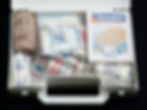Creating a First-Aid Kit for Equestrian and Equine

First-Aid kits are essential things to own for both equestrian and equine. Even if it's simply yourself and your horse, having a kit ready to go is great, just in case of an emergency. The emergency kits ought to contain items that will be able to treat an injury or emergency quickly until a professional can arrive. The kits need to be habitually checked and maintained to be ready at any moment.
When at an equine business, whether or not that be a facility or tack shop, having a kit promptly available for individuals and/or equine animals will provide a sense of safety in a grab-and-go scenario.
Not only should there be one at the business location, however, but a kit should also travel with you and/or in your horse trailer. Having a travel kit is great when you are attending shows or traveling with equines, in general, to different locations. With a travel kit, it tends to be compacted more than the business kit.
Creating lists of what is in every first-aid kit will assist in tracking what might be low or an expiration date on medicines. The lists can facilitate you that something has been used; for example, at an equine facility, I would tend to go through at least ten band-aids in three weeks because something random would happen. If I didn't keep track of my stock of band-aids, I would resort to using vet wrap. Then I would be going to two different stores for band-aids and vet wrap (I never could find both in the same stores for a reasonable price; I preferred to spend less than $3.99 on band-aids for myself) spending more time on the road. Then it takes away the time I could spend working.
Below are a few items that are recommended to have in first-aid kits, but customize them to fit you and your equine needs.
1. Paperwork

Paperwork facilitates decision-making and care that is or should be listed for the best treatments or previous treatments. All medical histories, treatments, medications or supplements, records of resting vitals, vaccination certificates, and any additional forms should be easy to get to. It is recommended to have all the papers in a water-resistant/waterproof type of storage.
2. Phone Numbers

Having easily accessible contact numbers allows others to call for assistance in case of an emergency. If all your numbers on your phone are locked, how will others be able to call someone in your emergency contact? Remember to always talk calmly and to the point when it comes to medical emergencies. Give all the information that you are aware of to the medical professionals.
3. Tools to Facilitate Treatments

Tools to facilitate treatments should be ready to grab and go. Having a halter, lead line with shank, and a twitch is never bad to have. Remember to have a form of light with extra battery life in those dark moments. Having a multi-tooled knife will be a tremendous help to have on you at all times for those imperative times that you may have to cut something. Also, having sanitizer or sanitizer wipes are to clean up the medical tools for a quick clean (I recommend a more thorough cleaning after each use of a tool(s), even if it is used on the same horse).
4. Medical Tools

Medical tools should include a thermometer, stethoscope, scissors, towels, and tweezers (knowing how to use each item and/or what to listen for is imperative). Have the normal temperature, pulse, respiration, and capillary refill close or even taped to the equine kit to compare numbers of your equine results to normal equine results (doesn't hurt to have the normal numbers for a human as well).
5. Medicines

Read all medicine labels carefully for shelf life, where to store, and the dosage. Epson Salts, Pepto Bismo/Maalox, Bute, Banamine are a few items that should be within the kit. Consult your vet for advice on the best medical kit to fit you and your equine needs.
6. Wound Care

Wound care products need to also be checked on shelf life for some products. Having saline solution, antiseptic soap scrub, 60cc syringe, antibacterial ointment, and hydrogen peroxide are great for those quick care fixes or cleaning a wound. Clean towels will always come in handy, and the same goes with surgical gloves.
7. Bandages

Being prepared with sterile rolled gauze, rolled cotton, nonstick dressing, leg quilts, vet wrap, band-aids, and duct tape will benefit when administering cover-up on a lesion and prevent anything from getting worse.
Check out our store and get a free checklist today!
<add link>
In Conclusion…
Consult with medical professionals for the best supplies to keep on hand for equestrians and equines. Learn how to best handle situations that will require people to stay calm, collected, and ready to take action.
Never be afraid to ask for support on mitigating emergencies and stay prepared for anything because it can (unfortunately) happen at any time.
Creating First-Aid kits is critical in being prepared for those 'oops' or 'oh no' moments. Equine and Equestrians can use similar supplies but always a good idea to have a separate kit and to always keep them clean and available.
Stay healthy, happy, and plan for anything. Thanks for joining the Equidae Family!
In the comments below, let us know what you keep in your medkits.
<Adsense>
